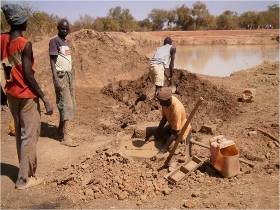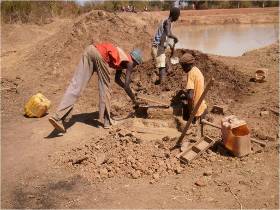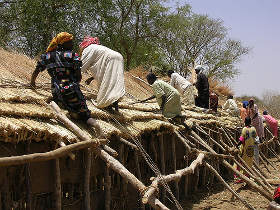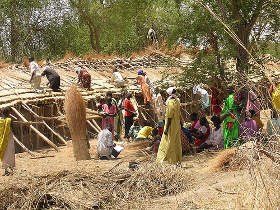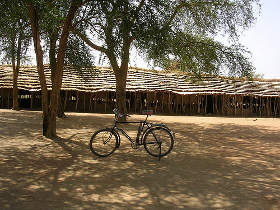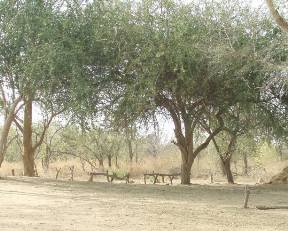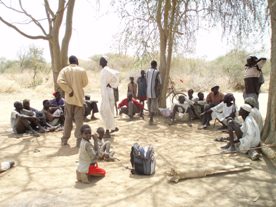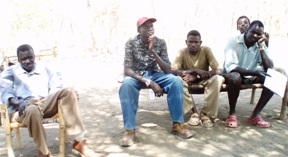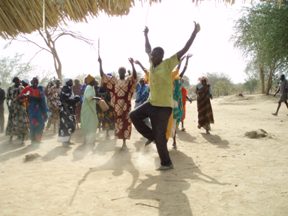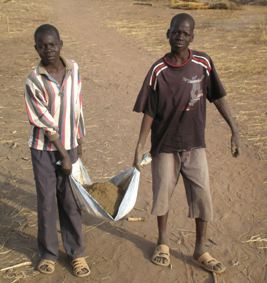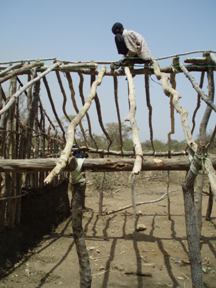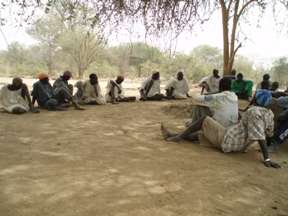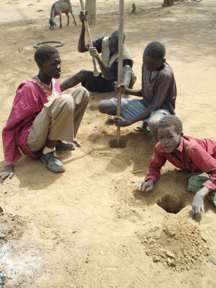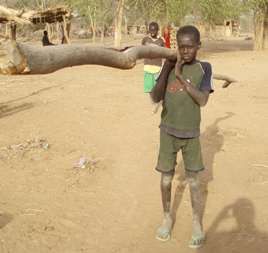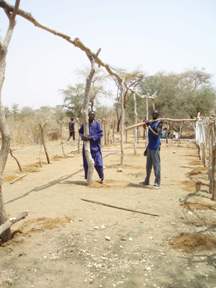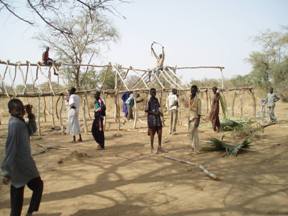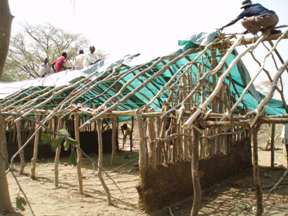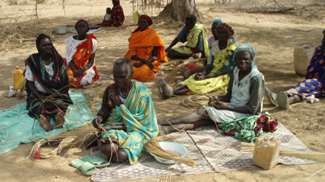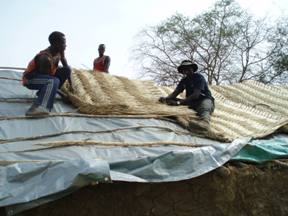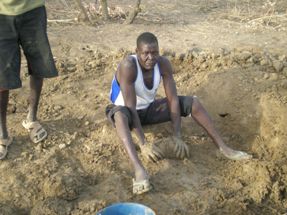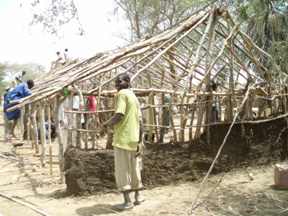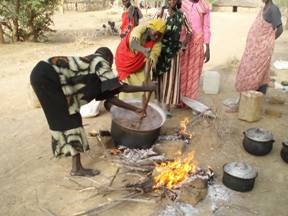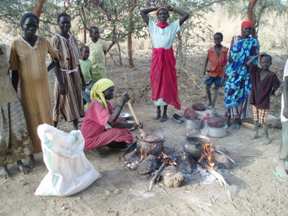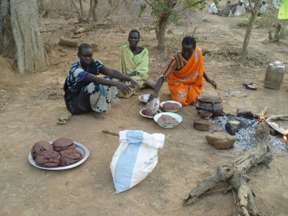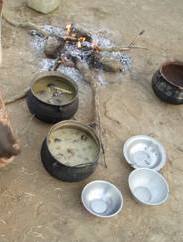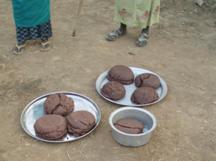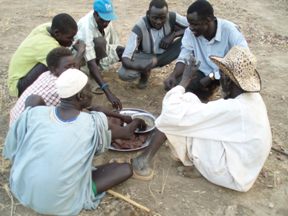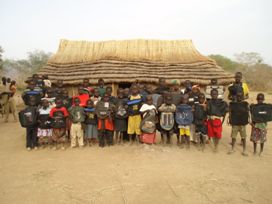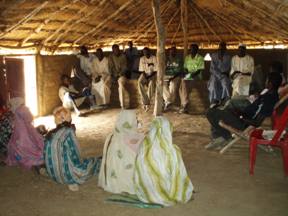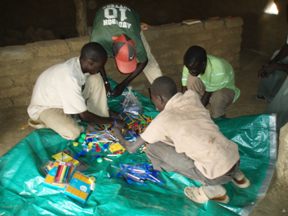2013 —
Wäramoth Primary School opened for the 2013 academic year in February.
2012 —
During the February 2012 visit, Timpir board members had several meetings with members of the school community, teachers, and members of the Parent Teacher Association to ensure the continued smooth operation of the school. The board was able to ensure the commitment of seven teachers to teach the Wäramoth students in 2012.
The school opened the 2012 academic year in April with 335 students (74 girls and 261 boys) in years 1-7 with seven teachers paid by Timpir. Because of the poor crop last season food is scarce. As such, Timpir will soon commence a food program for the students which entails purchasing sacks of sorghum and employing women from the community to cook lunches.
2011 —
The 2011 academic year ended with only three teachers teaching approximately 200 students who sat final exams in Years 1-6.
2010 — Making bricks
The Christmas period of 09/10 saw Timpir board member Garang Kuek travel at his own expense to South Sudan to see his family for the first time in over 20 years. This meant that Garang was also able to monitor the progress of Timpir’s projects and help implement additional projects.
When Garang arrived in December, he found that Wäramoth community members had already begun work making bricks for the permanent school structure that Timpir is supporting them to build.
The more permanent school structure will provide shelter for the 300+ students attending Wäramoth P.S from the rain of the wet season and the heat of the dry season, and a more durable solution than the temporary structure that Kuol and Mel worked with the community to build in 2008.
During the two months Garang spent in Sudan the community members made over 100,000 bricks which were burnt and carted to Wäramoth after his return.
Timpir provided funds to the Wäramoth school community to purchase brick moulds and to provide food and tea for the people who come to work at the brick making site, approximately an hour’s walk from the school location.
Additionally, Garang was present for the end-of-year graduation celebration at Wäramoth P.S. He attended along with dignitaries from the region including local chiefs and MPs to congratulate the 188 students who passed their end-of-year exams.
2009 — Community renovations and upgrade of school buildings
For most of the 2009 academic year, Timpir employed seven teachers at Wäramoth Primary School. There were over 370 students in six classes from Year 1 to Year 4. Timpir also employed 4 cooks to cook lunchtime meals for the students, as well as a watchman who stayed at the school overnight to take care of the school buildings and materials.
Following storms that blew off the tarpaulin and thatched roofing that had been used as a roof for the five classroom school building in 2008, the community decided that it would be best to put a traditional, semi-permanent grass roof on the building.
Timpir provided funding for the materials, and the women of the community provided the labour to install the more durable roof.
2007–2008 — School Building Period
When Mel and Kuol, two of Timpir’s Board Members initially arrived in Wäramoth in January 2007, they were astounded to see an under-tree school run by one volunteer teacher who came from the local community. Students sat on the ground or on benches constructed of tree trunks. The teachers used ‘boards’ accidentally delivered by the UN in the form of pallets protecting food-drop parcels during famine times. There were no teacher or student resources. The school closed when it rained.
Timpir identified Wäramoth Primary School in January 2007 as a school in need of assistance and development. Timpir financially assisted the local Wäramoth community to construct one school building during 2007. This school is now called Wäramoth Primary School in Wäramoth, Northern Bahr el Ghazal state, South Sudan.
Wäramoth is an area in South Sudan which is equivalent to a council ward in Australia. Wäramoth area comprises seven large suburbs that include Wäramoth, Luenhŋɔ̈ɔ̈r, Rumcir, Mabiörapiäl, Adɛ̈ɛ̈kbɛ̈y, Yinhagaany and Wärrïl. The school is right in the middle of Wäramoth area, immediately surrounded by Wäramoth, Luenhŋɔ̈ɔ̈r, Mabiörapiäl and Adɛ̈ɛ̈kbɛ̈y.
The construction of the initial school building was discussed in detail during a consultation with the elders of the Wäramoth Community. It was agreed that as much of the construction as possible would be completed free of charge by members of the community whose children attend the school. In this way, the use of the sd434,000 (US$2170) donated by Timpir could be utilised for those resources most desperately needed. This enabled the community to build one large permanent classroom.
Prior to the building of the school in Wäramoth, students had no choice but to attend Kajik Primary School which takes them 2–3 hours one way on foot. The big strong male pupils managed to attend Kajik Primary School for the year 2007, arriving at midday and having their classes in the afternoon. The pupils that attended Kajik Primary School in 2007 reported that they usually only had one lesson a day or none at all depending on the teacher.
The government employed teachers at Kajik Primary School also work on their farms and there is no way a pupil can find out whether the teacher is sick or working on the farm before arriving in the school. The pupils also reported that they were not assessed at the end of 2007. They are therefore not sure whether to repeat the same classes in 2008 or proceed without knowing they would have passed or not.
The younger pupils and the girls from Wäramoth area did not attend Kajik Primary School in 2007 because of physical reasons for younger pupils and because of social reasons for mature girls (too far for supervision).
During Mel and Kuol’s second visit to South Sudan in 2008 they met with potential teachers and discussed the need for additional classrooms and teachers to teach the 300 plus students enrolled in the school. It was decided that it would be necessary to build a 5 classroom structure for teaching during the wet season from May – November. The Wäramoth Community participated and after an initial meeting with the elders of the community, the workload was divided according to the sizes of the suburbs. There were four main work groups:
- Wäramoth
- Luenhŋɔ̈ɔ̈r & Rumcir
- Mabiörapiäl & Adɛ̈ɛ̈kbɛ̈y
- Yinhagaany & Wärrïl.
The members of each community brought ‘long poles’ and ‘short poles’ for the construction of the school on Saturday 23rd of February. During the Saturday working bee over 300 members of the community participated in both construction and cooking. Four billy goats and 100kg of sorghum were purchased and the women of each of the working group regions were given a billy and sorghum to cook for those who were working.
It was a fantastic day and all members of the community were very excited about the building of the new classrooms, but considering the 300 workers, progress was very slow. The basic structure of the school was finished on the Saturday, but it took many more days of hard work before the school was completed.
The enthusiasm for building waned over the following two weeks, but some hardworking stalwarts remained working. Timpir then decided to give remaining workers incentives of about AU$2.50 a day for a work that involved fetching building materials and building the walls. Some were quick and others were slow. Whatever the case, the work was priced evenly. For example, it was $35 to build approximately 4m x 2m wall. It took a week or less for some and two weeks or more for others to build their walls. We left others still working and did not pay them until the work was completed. Building a wall is no easy task. It initially requires carrying many jerry cans of water from the bore hole to a pile of dirt to create some mud before carrying the mud to the school building and piling it around the wooden poles that were put in place during the work day.
The final aspect of the building to be completed was the roof. The roofing consisted of criss-crossed wooden poles as the base which was then overlayed with ‘mashama’ (plastic sheeting) for water-proofing and finally hand-woven grass mats made by the local women were put on top to keep the classrooms cool under the hot sun.
The steps involved in building the five classroom complex were:
- Consulting with the community
- Digging the holes to put the timber poles into
- Women making local beer (very low alcohol content but is high in nutrients and made of sorghum) to be drunk by the men while they are building
- Carrying the poles from the various communities to the school (some up to two hours walk away)
- Putting the poles in to form the initial structure
- Putting the poles on to form the structure for the roofing
- Positioning and affixing plastic sheeting to keep the classrooms waterproof
- Hand weaving thatching to go on top of plastic sheeting
- Placing and affixing thatching on top of plastic sheeting
- Digging and preparing mud
- Putting mud around timber poles to form walls
For those who worked hard along the way, the women prepared plenty of food (donated by Timpir) and a feast was enjoyed by all!
While Kuol was in charge of building the structure, Mel was in charge of registering students. Over 300 students were registered in Years 1-3. Of these approximately 200 were in Year 1. The Year 1 students range in age from 7-17. This was the first time that these 200 children have had the opportunity to attend school.
During one of the short breaks from building, we arranged a parent-teacher committee. This was the first time that many of the parents had ever been involved with the schooling of their children. In most Sudanese schools children find their own way to school in the mornings and their own way home at night, and parents do not get involved with their children’s schooling. Our hope is that parents and teachers will work in partnership to make Wäramoth Primary School a success and give their children the best education possible.
Finally, two teachers were employed to facilitate the day to day operation of the school. This included looking after and distributing all of the school bags donated for Timpir’s Christmas gift program and the stationery donated by staff at the University of South Australia
Wäramoth Primary School opened on March 17th, 2008 with over 300 students, two salaried teachers and four volunteer teachers. It has been a challenging, but immensely rewarding journey thus far. I can’t wait to see where we will progress to in the future!

